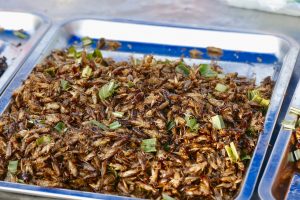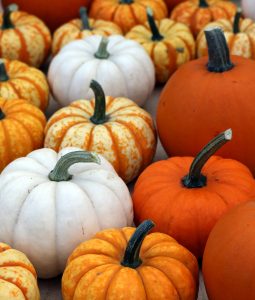John wore clothing made of camel’s hair and had a leather belt around his waist. His food was locusts and wild honey.
— Matthew 3:4, New American Bible Revised Edition
People around the world have been eating insects for thousands of years. In 2018, the Asia-Pacific region accounted for nearly 43% of the edible insect market worldwide, followed by Latin America (22.7%), and Europe (20.2%). By country, some of the largest markets include Thailand, Japan, China, Australia, and Peru. In Thailand, many people enjoy deep-fried insects as snacks and typically wash them down with their favorite beer. Globally, traditional diets include around 1,900 insect species.1 Beetles are the most numerous (659 species); followed by caterpillars (362); ants, bees, and wasps (321) and grasshoppers and locusts (278). Several species of true bugs, dragonflies, termites, flies, cockroaches, and spiders among others are also considered edible.2
Insects are high in protein (nearly equivalent to that of beef, pork, and poultry), require significantly less land, feed, and water than livestock, and farming them emits significantly fewer greenhouse gases (2 grams of greenhouse gases per kg of weight for insects vs 2,850 grams of greenhouse gases per kg of weight for cattle). As a result, insects are considered by some to be an eco-friendly alternative to beef, pork, and chicken. According to Innova Market Insights, insect protein will become a popular meat alternative in 2019 as consumers continue to demand healthy and eco-conscious foods. Recently some high-end restaurants in the United States and Europe began incorporating insects into some of the dishes offered on their menus. But what about the “ick factor”? According to Christine Couvelier, a chef and food industry consultant, “cricket powder is the best way to introduce this.” Crickets, processed into a tasteless powder or flour, can be added to a variety of foods such as sausages, granola, soups, pasta, desserts or bread to give the foods added protein, vitamins, and amino acids. The increasing use of insects in sports and dietary supplements used by athletes is expected to help drive demand also.
Today’s market size shows the total worldwide revenues for edible insects in 2017 and 2024 according to Global Market Insights.3 The figure for 2024 is projected. Not all edible insects are consumed by humans. Grasshoppers are food for pet fish, turtles, and birds. In the aquaculture industry, black soldier fly larvae and maggots are substitutes for fishmeal. A variety of insects, including beetles, cockroaches, termites, and ants, are food sources for poultry. Demand for edible insects in this market is expected to grow in the next five years. Currently, soymeal constitutes 65% of poultry and cattle feed. Research is underway by some manufacturers of edible insects to potentially replace 10-50% of soymeal feed with black soldier fly larvae, grasshoppers, silkworms or mealworms. These insects have similar nutrient content to traditional soymeal feed. Leading firms in the edible insect market include EnviroFlight, Haocheng Mealworm, AgriProtein, and Entomo Farms.
1 Source: Agnieszka de Sousa, Hayley Warren, and Roni Rekomaa, “Bugs Are Coming Soon to Your Dinner Table,” Bloomberg, July 5, 2018 available online here.2 Source: “List of Edible Insects of the World,” Wageningen University & Research, the Netherlands available online here. According to Yde Jongema, a taxonomist at the Department of Entomology of Wageningen University and Research, as of April 1, 2017, there were 2,111 species of edible insects in the world.
3 The North American Coalition for Insect Agriculture citing Research and Markets and Meticulous Research both predict that the edible insect market will reach $1.2 billion by 2023.
Geographic reference: World
Year: 2017 and 2024
Market size: $55 million and $710 million, respectively
Sources: Kunal Ahuja and Shreya Deb, “Global Edible Insects Market to Exceed $710 Mn by 2024,” Global Market Insights, June 20, 2018 available online here; Agnieszka de Sousa, Hayley Warren, and Roni Rekomaa, “Bugs Are Coming Soon to Your Dinner Table,” Bloomberg, July 5, 2018 available online here; “List of Edible Insects of the World,” Wageningen University & Research, the Netherlands available online here; Sean Rossman, “Bugs in Your Food? Might Be on Purpose,” USA Today for the Lansing State Journal, December 23, 2018, pages 1B and 2B; Stacie Goldin, “Eating Insects in Thailand,” Entomo Farms, May 19, 2016 available online here; Kunal Ahuja and Shreya Deb, “Edible Insects Market Size By Product (Beetles, Caterpillars, Grasshoppers, Bees, Wasps, Ants, Scale Insects & True Bugs), By Application (Flour, Protein Bars, Snacks), Industry Analysis Report, Regional Outlook (U.S., Belgium, Netherlands, UK, France, China, Thailand, Vietnam, Brazil, Mexico), Application Potential, Price Trends, Competitive Market Share & Forecast, 2018 – 2024,” Global Market Insights, June 2018 available online here; Courtney Johnson, “Edible Insects Market Seeing Growth,” Natural Products Insider, July 15, 2016 available online here.
Image source: Satya Prem, “food-insect-nutrition-eat-protein-3348724,” Pixabay, April 24, 2018 available online here.




















